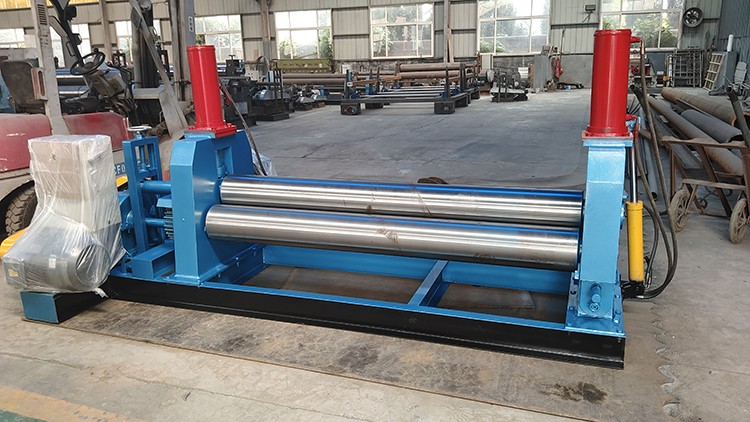From obscurity to industry leader, over a decade of dedication has established us as a pioneer in the field of plate rolling machine manufacturing. Today, we invite you to explore the adjustment methods for the rear material positioning accuracy of plate rolling machines:
A plate rolling machine is a key piece of equipment in metal sheet processing, primarily used to roll metal sheets into arc-shaped or cylindrical workpieces. As an important component of the plate rolling machine, the rear stopper device plays a crucial role in sheet positioning, with its positioning accuracy directly affecting the forming quality and dimensional accuracy of the workpiece. This article will systematically introduce the adjustment methods for the positioning accuracy of the rear stopper device on a plate rolling machine, helping operators master the correct adjustment techniques.
1. Preparatory work before adjustment
Before beginning the adjustment of the rear material stop device, thorough preparatory work must be completed. First, ensure that the rolling machine is completely shut down, disconnect the main power supply, and hang safety warning signs. Check that all moving parts of the equipment have stopped operating and that the hydraulic system pressure has been fully released. Prepare the necessary testing tools, including a dial indicator (accuracy 0.01 mm), feeler gauge set, and leveling instrument (accuracy 0.02 mm/m). Additionally, prepare clean wiping cloths, specialized lubricating oil, and other maintenance supplies.
2. Mechanical structure inspection and adjustment
(1)Guide Rail Inspection: Use a dial indicator to measure the straightness error of the rear stop guide rail. The runout during full travel should not exceed 0.05 mm. If severe wear is detected, the guide rail should be reground or replaced.
(2)Transmission System Inspection: For lead screw transmission structures, measure the backlash and ensure it is within 0.03 mm; for synchronous belt transmission, inspect the belt tension to prevent slippage.
(3)Reference surface calibration: Use a precision straightedge to check the flatness of the material positioning surface, and use a feeler gauge to measure the gap, which should not exceed 0.05 mm.
3. Electrical system parameter settings
CNC plate rolling machines require reasonable control system parameter settings:
(1)Servo parameters: Adjust the position loop gain to between 40-60% and the speed loop gain to between 50-70%.
(2)Zero calibration: Accurately set the encoder zero position to ensure accurate position feedback.
(3)Motion parameters: Set reasonable acceleration and deceleration to avoid positioning overshoot caused by sudden stops and starts.
(4)Limit settings: Soft limits should be set 5-10 mm ahead of mechanical limits to ensure safety.
4. Step-by-step adjustment operation process
(1)Coarse adjustment stage: Loosen the material retaining bolts, manually move to the reference position, and use a dial indicator to preliminarily measure the deviation.
(2)Fine adjustment stage: Use the control system to make fine adjustments, gradually controlling the positioning error to within 0.05 mm.
(3)Tightening inspection: Tighten all fixing bolts to the standard torque value, then re-measure the positioning accuracy.
(4)Coarse adjustment stage: Loosen the material retaining bolts, manually move to the reference position, and use a dial indicator to preliminarily measure the deviation.
(5)Fine adjustment stage: Use the control system to make fine adjustments, gradually controlling the positioning error to within 0.05 mm.
(6) Tightening inspection: Tighten all fixing bolts to the standard torque value, then re-measure the positioning accuracy.
5. Accuracy verification and testing
After adjustment, actual verification must be performed:
(1)Perform rolling tests using standard test plates.
(2)Measure the misalignment of the formed workpiece. The acceptable standard is within 5% of the plate thickness.
(3)Check the gap at the overlap. It should not exceed 0.1 mm.
(4)Establish a random inspection system for mass production. Inspect the material stop accuracy once every 10 pieces.
6. Key points for daily maintenance
(1)Clean the guide rails weekly and apply the specified type of grease.
(2)Check the wear and tear of the transmission components monthly.
(3)Conduct a comprehensive inspection of positioning accuracy quarterly.
(4)Establish a precision record for the equipment and record maintenance details.
(5)Avoid overloading the equipment during operation and prevent mechanical impact.
7.Troubleshooting Common Issues
(1)Inaccurate positioning: Check the lubrication status of the guide rails and the clearance of the transmission system.
(2)Single-sided deviation: Re-calibrate the parallelism of the guide rails.
(3)Servo malfunction: Check the encoder connection and feedback signal.
(4)Mechanical noise: Immediately shut down the machine and inspect the transmission components.
(5)Data loss: Regularly back up system parameters.
Adjusting the positioning accuracy of the rear stop on a plate rolling machine is a task that requires patience and attention to detail. Operators must be familiar with the mechanical structure of the equipment and understand the parameter settings of the electrical system. By following standardized adjustment procedures and implementing scientific maintenance methods, the plate rolling machine can be kept in optimal working condition at all times. It is recommended that companies organize regular technical training sessions to enhance the professional skills of operators, thereby ensuring the production of high-quality products.
If you are interested in plate rolling machines, please contact us.



 Address:Room 1202, Detaitang Building, No. 118 Huaguang Road, Zhangdian District, Zibo, Shandong
Address:Room 1202, Detaitang Building, No. 118 Huaguang Road, Zhangdian District, Zibo, Shandong WhatsApp:+8615653328535
WhatsApp:+8615653328535 Wechat: +8615965331535
Wechat: +8615965331535  E-mail:zs@sdsmachinery.com
E-mail:zs@sdsmachinery.com